Attached files
| file | filename |
|---|---|
| 8-K - FORM 8-K - CYS Investments, Inc. | d233064d8k.htm |
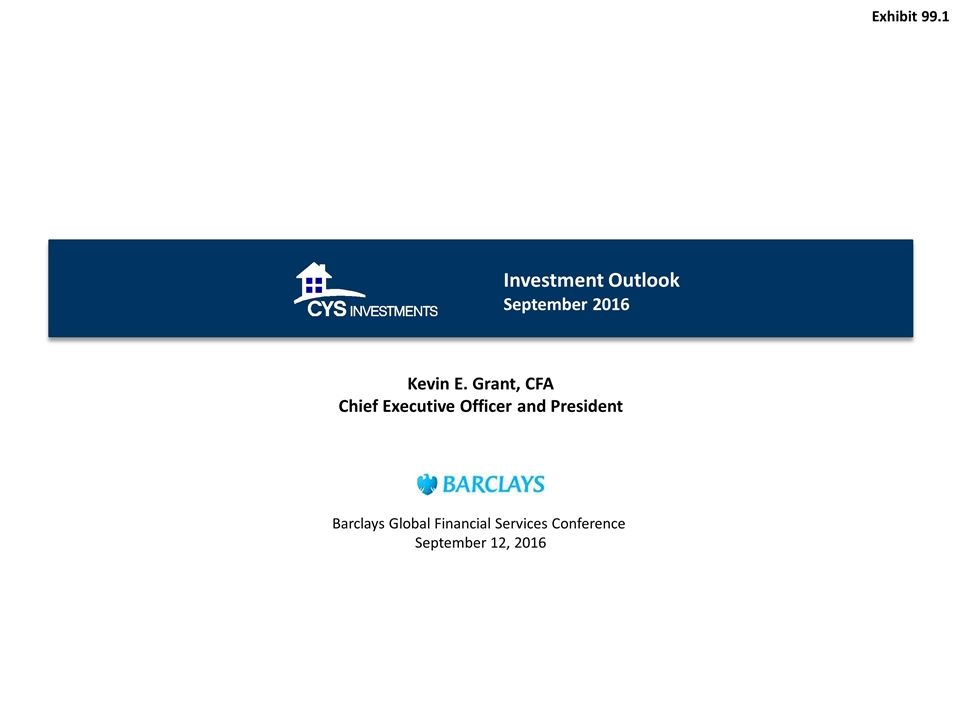
Kevin E. Grant, CFA Chief Executive Officer and President Investment Outlook September 2016 Barclays Global Financial Services Conference September 12, 2016 Exhibit 99.1
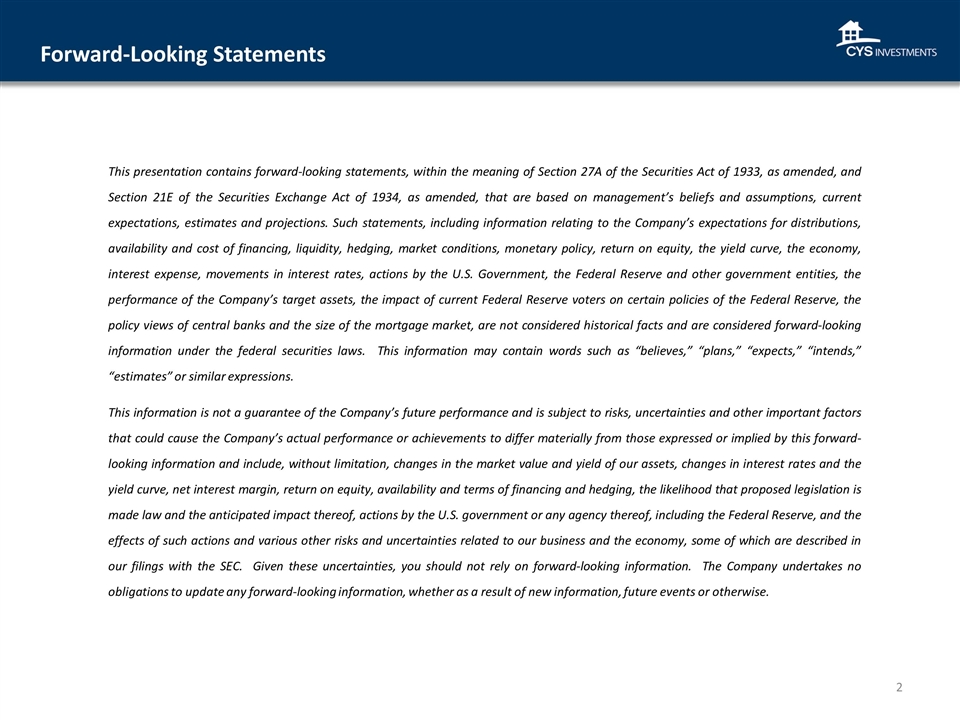
Forward-Looking Statements This presentation contains forward-looking statements, within the meaning of Section 27A of the Securities Act of 1933, as amended, and Section 21E of the Securities Exchange Act of 1934, as amended, that are based on management’s beliefs and assumptions, current expectations, estimates and projections. Such statements, including information relating to the Company’s expectations for distributions, availability and cost of financing, liquidity, hedging, market conditions, monetary policy, return on equity, the yield curve, the economy, interest expense, movements in interest rates, actions by the U.S. Government, the Federal Reserve and other government entities, the performance of the Company’s target assets, the impact of current Federal Reserve voters on certain policies of the Federal Reserve, the policy views of central banks and the size of the mortgage market, are not considered historical facts and are considered forward-looking information under the federal securities laws. This information may contain words such as “believes,” “plans,” “expects,” “intends,” “estimates” or similar expressions. This information is not a guarantee of the Company’s future performance and is subject to risks, uncertainties and other important factors that could cause the Company’s actual performance or achievements to differ materially from those expressed or implied by this forward-looking information and include, without limitation, changes in the market value and yield of our assets, changes in interest rates and the yield curve, net interest margin, return on equity, availability and terms of financing and hedging, the likelihood that proposed legislation is made law and the anticipated impact thereof, actions by the U.S. government or any agency thereof, including the Federal Reserve, and the effects of such actions and various other risks and uncertainties related to our business and the economy, some of which are described in our filings with the SEC. Given these uncertainties, you should not rely on forward-looking information. The Company undertakes no obligations to update any forward-looking information, whether as a result of new information, future events or otherwise.
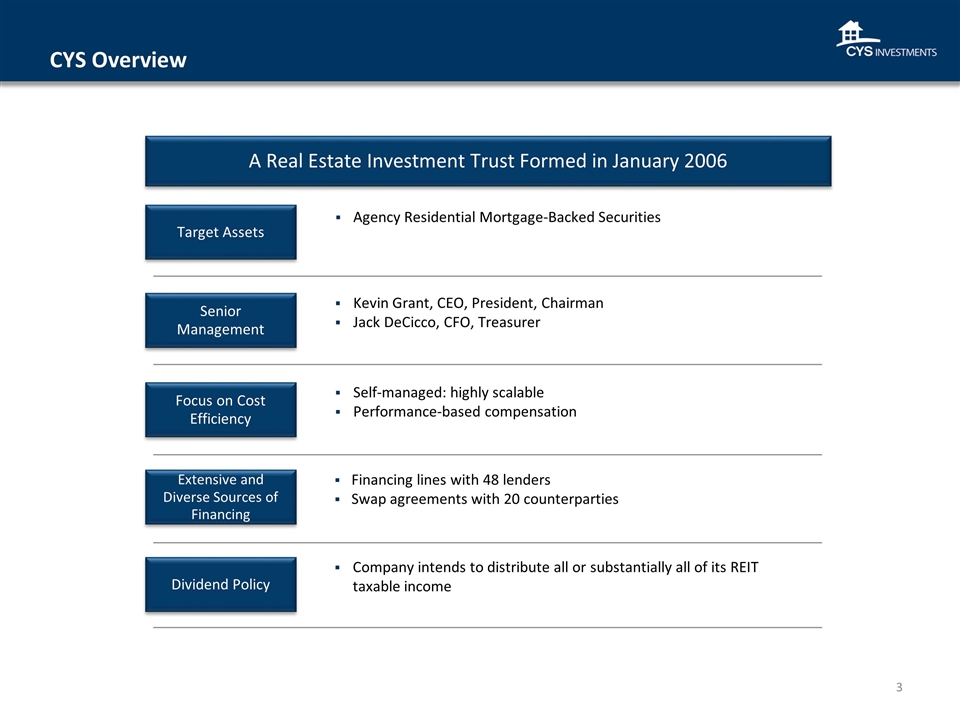
CYS Overview Focus on Cost Efficiency Target Assets Agency Residential Mortgage-Backed Securities A Real Estate Investment Trust Formed in January 2006 Extensive and Diverse Sources of Financing Financing lines with 48 lenders Swap agreements with 20 counterparties Dividend Policy Self-managed: highly scalable Performance-based compensation Senior Management Kevin Grant, CEO, President, Chairman Jack DeCicco, CFO, Treasurer Company intends to distribute all or substantially all of its REIT taxable income

Agency MBS Market Continues To See Strong Demand 15 Year: Hedged vs. Unhedged 15 Year Fixed Hedged with Swaps: April 2009 - September 2016 15 Year Hedged (i) 15 Year Unhedged (ii) Borrow Short Invest Long September 9, 2016 Source: Bloomberg. Note: Spreads calculated as: (i) 15 year Current Coupon Index = 50% 4 year swap, and (ii) 15 year Current Coupon Index
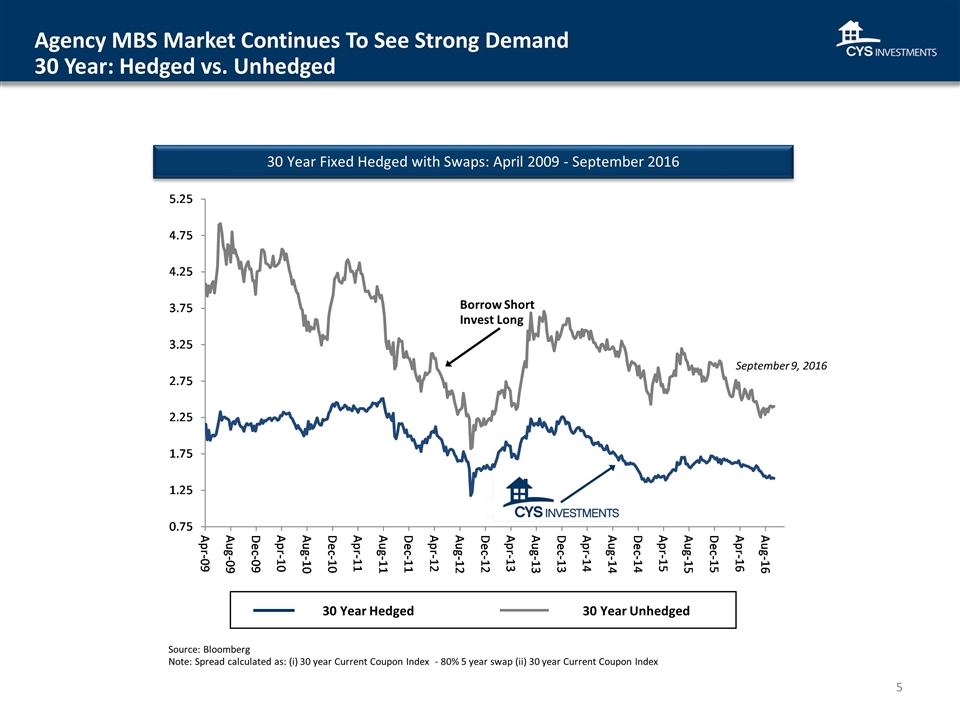
Agency MBS Market Continues To See Strong Demand 30 Year: Hedged vs. Unhedged 30 Year Hedged 30 Year Unhedged Borrow Short Invest Long 30 Year Fixed Hedged with Swaps: April 2009 - September 2016 September 9, 2016 Source: Bloomberg Note: Spread calculated as: (i) 30 year Current Coupon Index - 80% 5 year swap (ii) 30 year Current Coupon Index

Volatility in the Cap/Floor Markets Hit a Low in July 2013 30 Yr MBS - 15 Yr MBS Spread 7 Yr Cap/Floor Implied Vol April 2012 - September 2016 30 Year MBS remain cheaper than 15 Year MBS 5 Year Swap vs. Fed Funds January 2005 - September 2016 Yield Curve Creates positive carry Low cost of financing Good ROE Very low hedging cost Fed still fighting deflation Agency REIT Economics Remain Good November 2012 - September 2016 September 9, 2016 Source: Bloomberg September 9, 2016 September 9, 2016 September 9, 2016
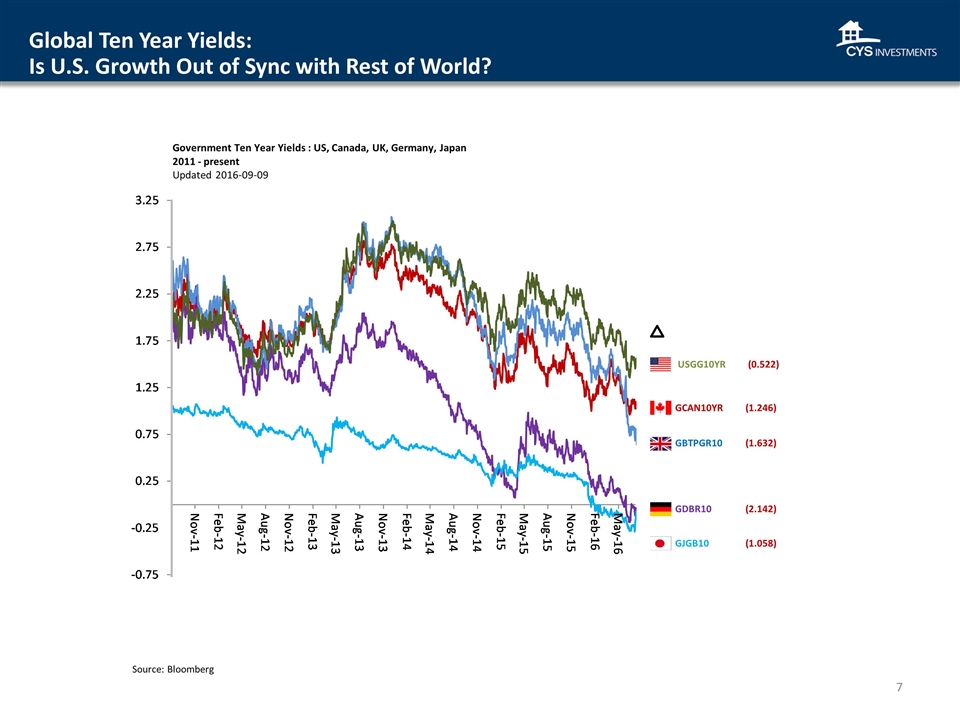
Global Ten Year Yields: Is U.S. Growth Out of Sync with Rest of World? Source: Bloomberg Government Ten Year Yields : US, Canada, UK, Germany, Japan 2011 - present Updated 2016-09-09 USGG10YR (0.522) GBTPGR10 (1.632) GCAN10YR (1.246) GDBR10 (2.142) GJGB10 (1.058)
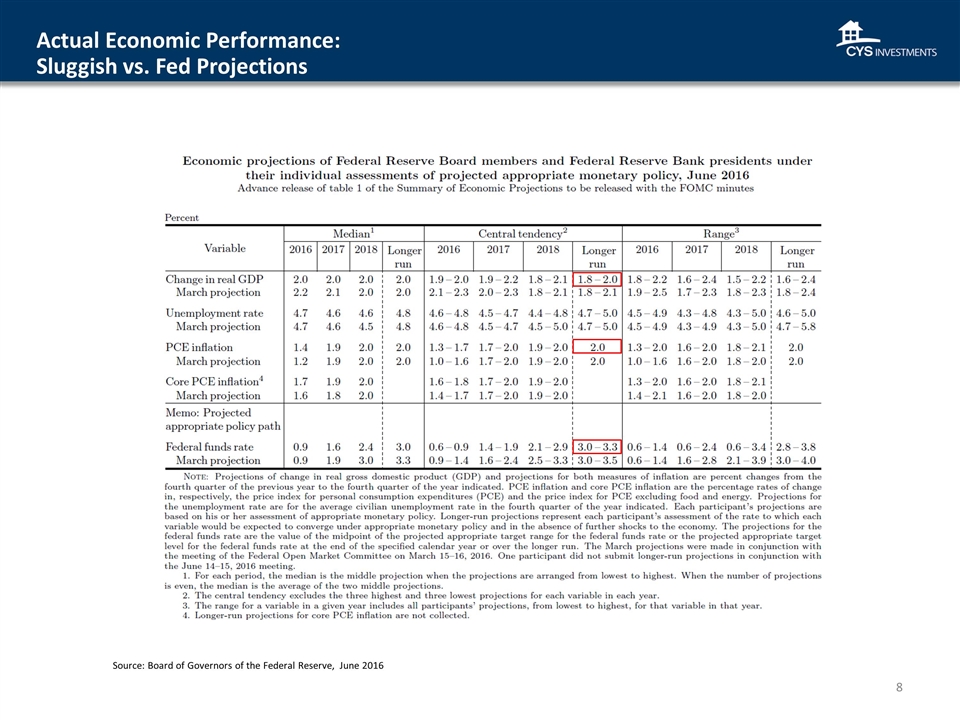
Source: Board of Governors of the Federal Reserve, June 2016 Actual Economic Performance: Sluggish vs. Fed Projections
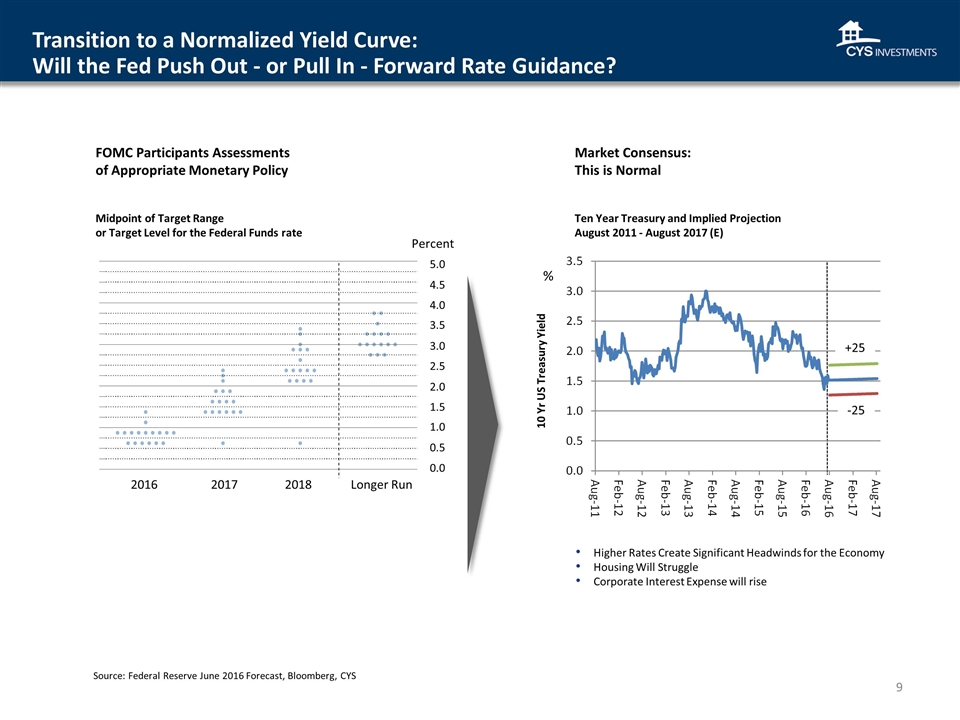
Midpoint of Target Range or Target Level for the Federal Funds rate Higher Rates Create Significant Headwinds for the Economy Housing Will Struggle Corporate Interest Expense will rise Percent FOMC Participants Assessments of Appropriate Monetary Policy Market Consensus: This is Normal Transition to a Normalized Yield Curve: Will the Fed Push Out - or Pull In - Forward Rate Guidance? Ten Year Treasury and Implied Projection August 2011 - August 2017 (E) +25 -25 % Source: Federal Reserve June 2016 Forecast, Bloomberg, CYS 10 Yr US Treasury Yield 2016 Longer Run 2018 2017 0.0 2.0 2.5 3.0 3.5 4.0 4.5 5.0 0.5 1.0 1.5 +25 -25
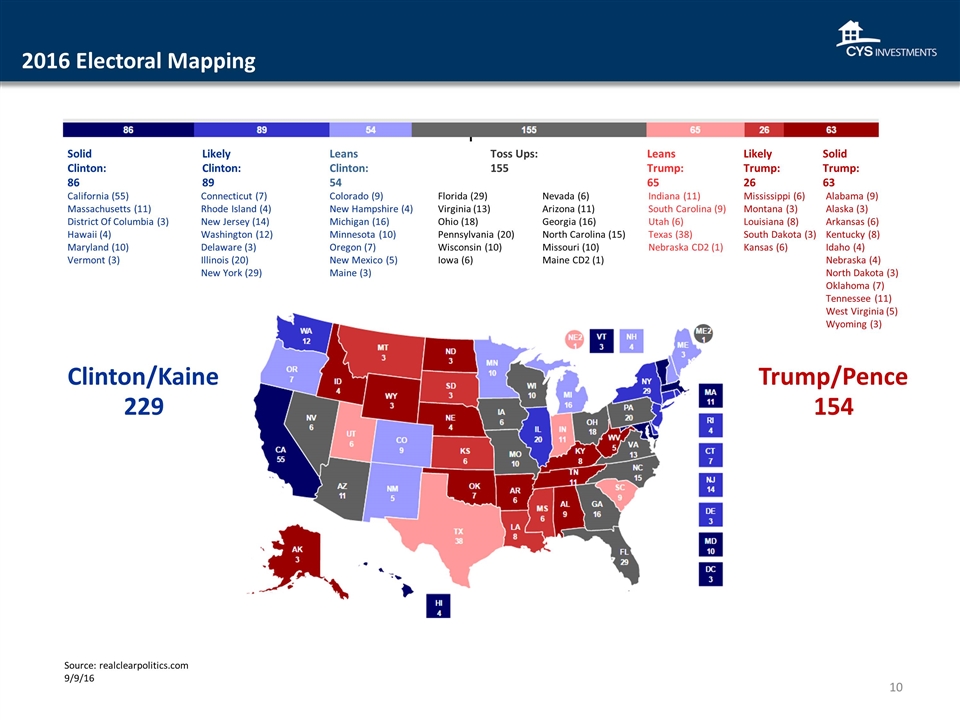
Indiana (11) South Carolina (9) Utah (6) Texas (38) Nebraska CD2 (1) Leans Trump: 65 Connecticut (7) Rhode Island (4) New Jersey (14) Washington (12) Delaware (3) Illinois (20) New York (29) Likely Clinton: 89 Source: realclearpolitics.com 9/9/16 Solid Clinton: 86 California (55) Massachusetts (11) District Of Columbia (3) Hawaii (4) Maryland (10) Vermont (3) Likely Trump: 26 Mississippi (6) Montana (3) Louisiana (8) South Dakota (3) Kansas (6) Solid Trump: 63 Alabama (9) Alaska (3) Arkansas (6) Kentucky (8) Idaho (4) Nebraska (4) North Dakota (3) Oklahoma (7) Tennessee (11) West Virginia (5) Wyoming (3) 2016 Electoral Mapping Colorado (9) New Hampshire (4) Michigan (16) Minnesota (10) Oregon (7) New Mexico (5) Maine (3) Leans Clinton: 54 229 Clinton/Kaine 154 Trump/Pence Florida (29) Virginia (13) Ohio (18) Pennsylvania (20) Wisconsin (10) Iowa (6) Toss Ups: 155 Nevada (6) Arizona (11) Georgia (16) North Carolina (15) Missouri (10) Maine CD2 (1)
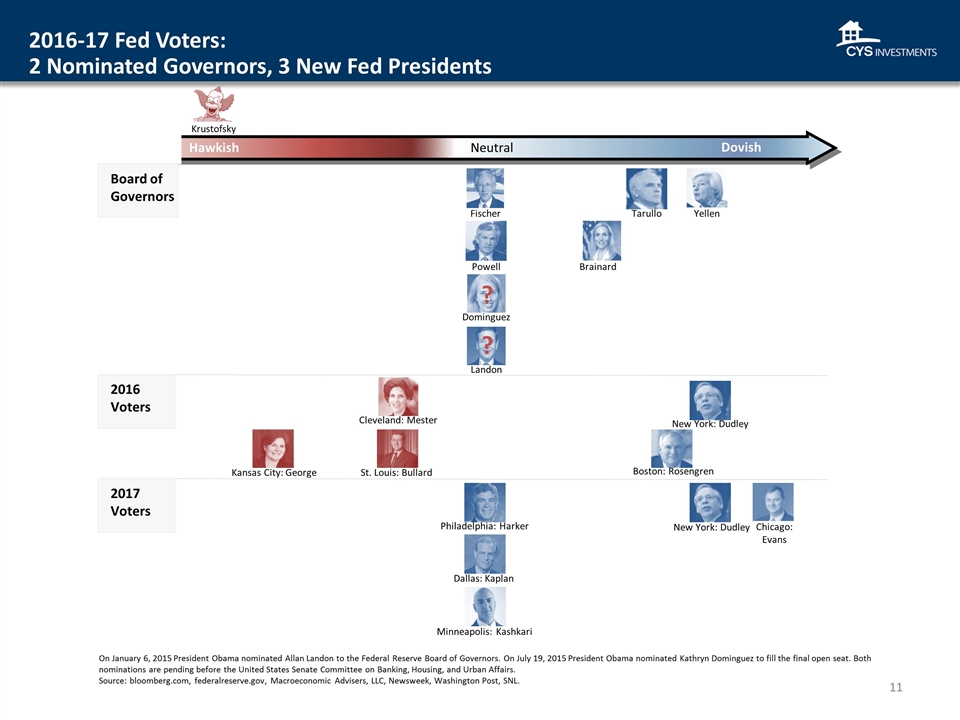
2016-17 Fed Voters: 2 Nominated Governors, 3 New Fed Presidents Powell On January 6, 2015 President Obama nominated Allan Landon to the Federal Reserve Board of Governors. On July 19, 2015 President Obama nominated Kathryn Dominguez to fill the final open seat. Both nominations are pending before the United States Senate Committee on Banking, Housing, and Urban Affairs. Source: bloomberg.com, federalreserve.gov, Macroeconomic Advisers, LLC, Newsweek, Washington Post, SNL. Hawkish Dovish Neutral Yellen Board of Governors Fischer Brainard Tarullo 2016 Voters New York: Dudley 2017 Voters New York: Dudley Cleveland: Mester Boston: Rosengren Kansas City: George St. Louis: Bullard Dominguez Landon ? ? Chicago: Evans Philadelphia: Harker Dallas: Kaplan Minneapolis: Kashkari Krustofsky
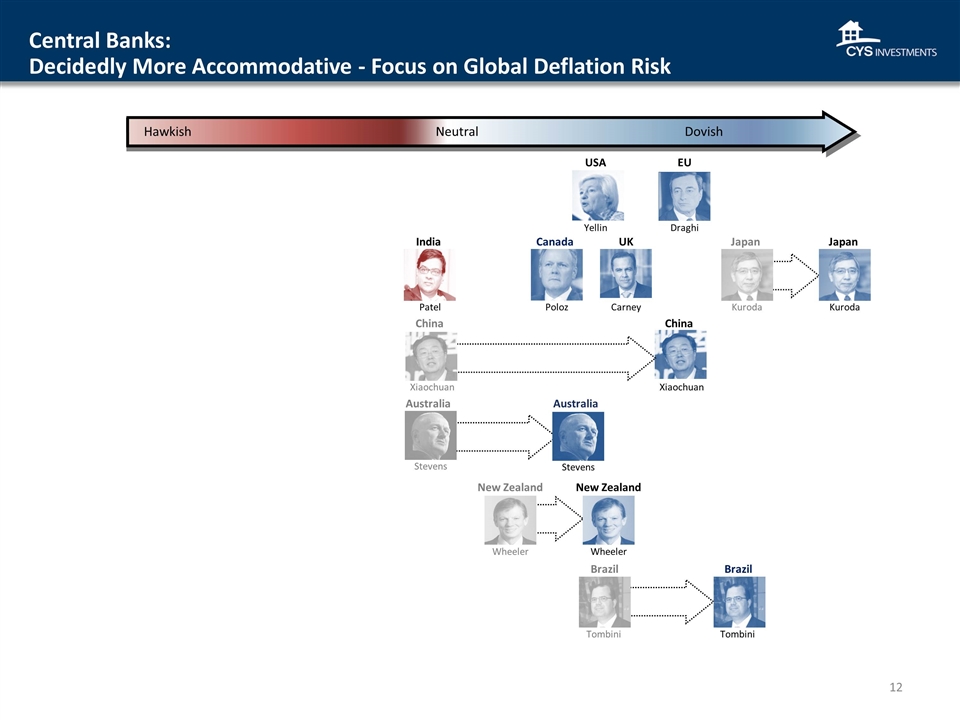
Central Banks: Decidedly More Accommodative - Focus on Global Deflation Risk Draghi EU Hawkish Dovish Neutral Xiaochuan China Xiaochuan China Tombini Brazil Tombini Brazil Australia Stevens Australia Stevens New Zealand Wheeler New Zealand Wheeler Kuroda Japan Canada Poloz Patel India Kuroda Japan Carney UK Yellin USA
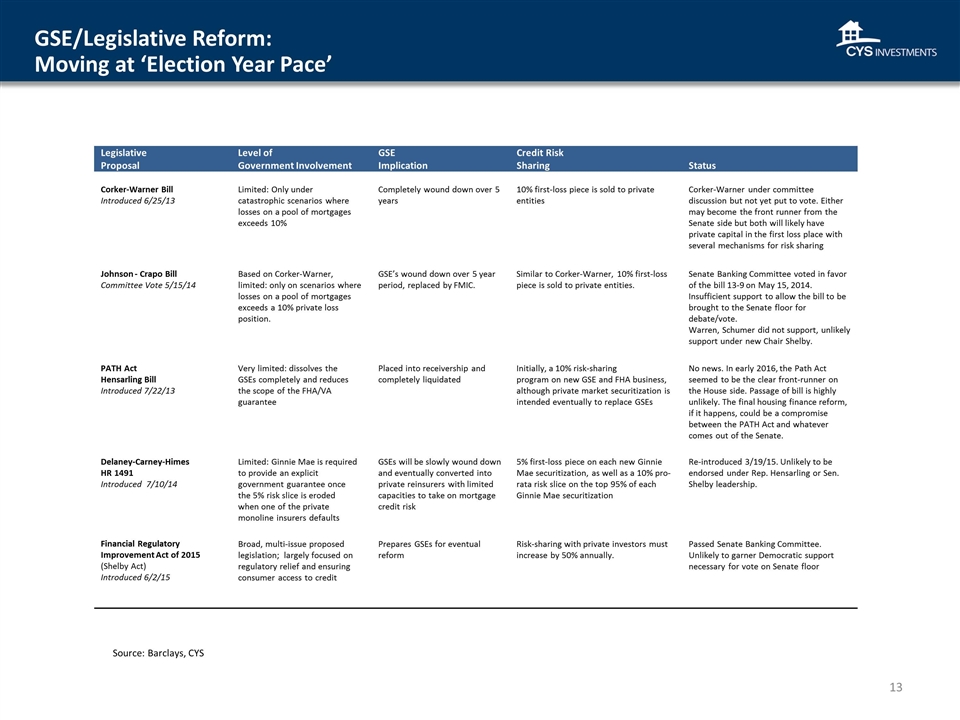
GSE/Legislative Reform: Moving at ‘Election Year Pace’ Source: Barclays, CYS Legislative Proposal Level of Government Involvement GSE Implication Credit Risk Sharing Status Corker-Warner Bill Introduced 6/25/13 Limited: Only under catastrophic scenarios where losses on a pool of mortgages exceeds 10% Completely wound down over 5 years 10% first-loss piece is sold to private entities Corker-Warner under committee discussion but not yet put to vote. Either may become the front runner from the Senate side but both will likely have private capital in the first loss place with several mechanisms for risk sharing Johnson - Crapo Bill Committee Vote 5/15/14 Based on Corker-Warner, limited: only on scenarios where losses on a pool of mortgages exceeds a 10% private loss position. GSE’s wound down over 5 year period, replaced by FMIC. Similar to Corker-Warner, 10% first-loss piece is sold to private entities. Senate Banking Committee voted in favor of the bill 13-9 on May 15, 2014. Insufficient support to allow the bill to be brought to the Senate floor for debate/vote. Warren, Schumer did not support, unlikely support under new Chair Shelby. PATH Act Hensarling Bill Introduced 7/22/13 Very limited: dissolves the GSEs completely and reduces the scope of the FHA/VA guarantee Placed into receivership and completely liquidated Initially, a 10% risk-sharing program on new GSE and FHA business, although private market securitization is intended eventually to replace GSEs No news. In early 2016, the Path Act seemed to be the clear front-runner on the House side. Passage of bill is highly unlikely. The final housing finance reform, if it happens, could be a compromise between the PATH Act and whatever comes out of the Senate. Delaney-Carney-Himes HR 1491 Introduced 7/10/14 Limited: Ginnie Mae is required to provide an explicit government guarantee once the 5% risk slice is eroded when one of the private monoline insurers defaults GSEs will be slowly wound down and eventually converted into private reinsurers with limited capacities to take on mortgage credit risk 5% first-loss piece on each new Ginnie Mae securitization, as well as a 10% pro-rata risk slice on the top 95% of each Ginnie Mae securitization Re-introduced 3/19/15. Unlikely to be endorsed under Rep. Hensarling or Sen. Shelby leadership. Financial Regulatory Improvement Act of 2015 (Shelby Act) Introduced 6/2/15 Broad, multi-issue proposed legislation; largely focused on regulatory relief and ensuring consumer access to credit Prepares GSEs for eventual reform Risk-sharing with private investors must increase by 50% annually. Passed Senate Banking Committee. Unlikely to garner Democratic support necessary for vote on Senate floor
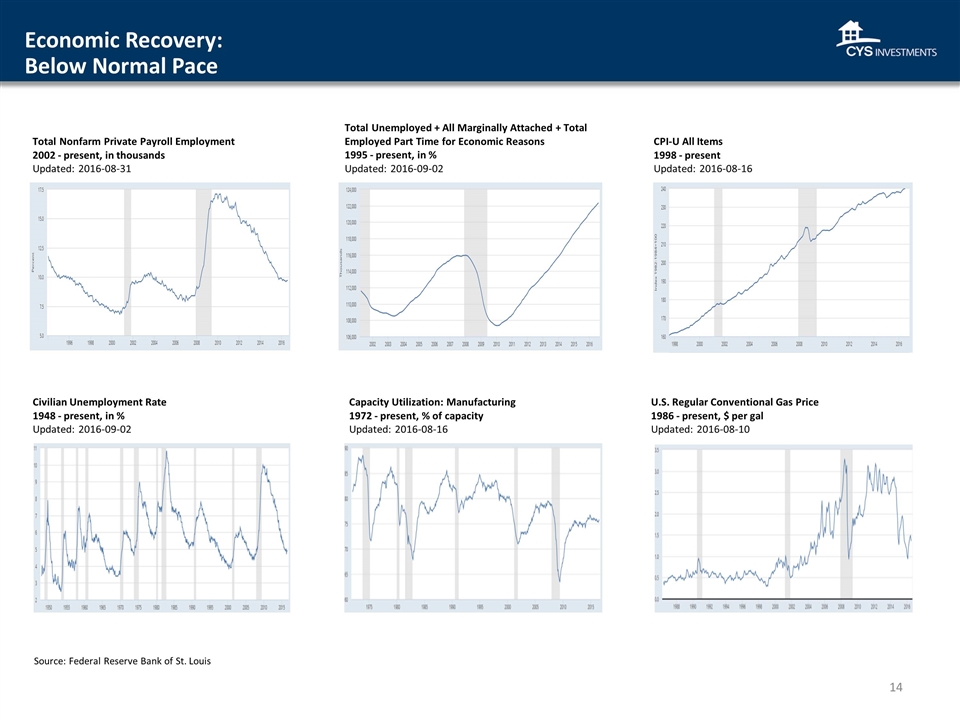
Economic Recovery: Below Normal Pace U.S. Regular Conventional Gas Price 1986 - present, $ per gal Updated: 2016-08-10 Capacity Utilization: Manufacturing 1972 - present, % of capacity Updated: 2016-08-16 Civilian Unemployment Rate 1948 - present, in % Updated: 2016-09-02 CPI-U All Items 1998 - present Updated: 2016-08-16 Total Nonfarm Private Payroll Employment 2002 - present, in thousands Updated: 2016-08-31 Total Unemployed + All Marginally Attached + Total Employed Part Time for Economic Reasons 1995 - present, in % Updated: 2016-09-02 Source: Federal Reserve Bank of St. Louis

Economic Recovery (2): Below Normal Pace Aggregate Homeownership Rate 2000 - 2016 Housing Starts 2000 - 2016 Manufacturing and ISM Manufacturing Data 2000 - 2016 GDP Growth 2000 - 2016 GDP 2000 - 2016 Labor Market Indicators 2000 - 2016 Source: Federal Reserve Bank of New York, Bureau of Economic Analysis via Haver Analytics

Housing Finance: No Rebound Source: U.S. Census Bureau and National Association of Realtors. St Louis Fed, www.census.gov Share of Government Guaranteed Mortgages 1990 – 2016, in % Monthly Supply of Houses 1963- present Updated: 2016-08-23 Home Ownership Rate 1965- present, in % Updated: 2016-07-28
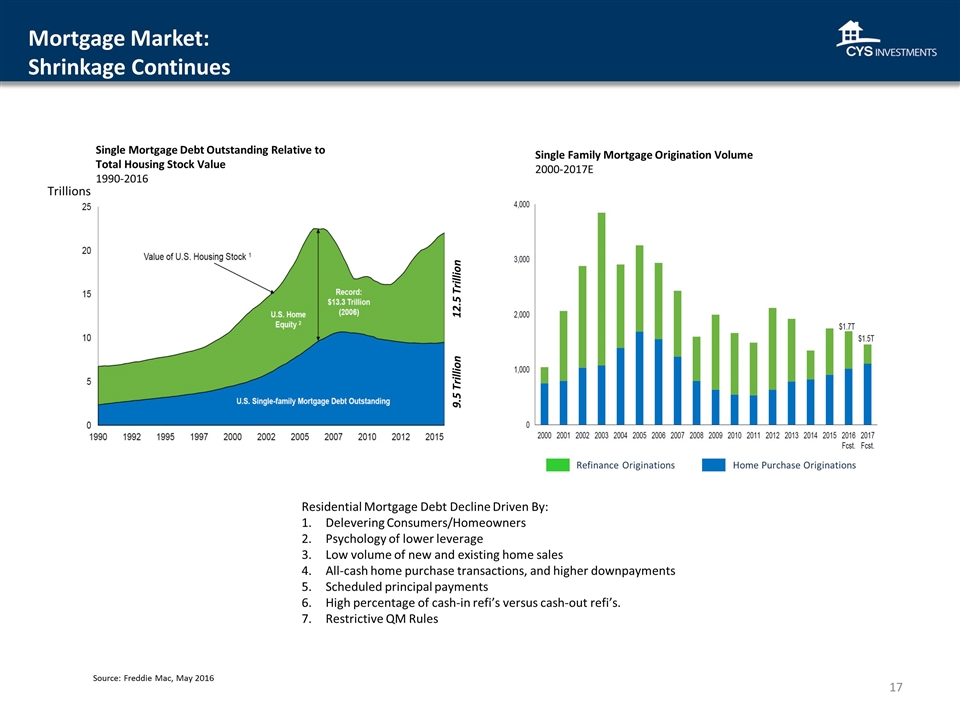
Mortgage Market: Shrinkage Continues Residential Mortgage Debt Decline Driven By: Delevering Consumers/Homeowners Psychology of lower leverage Low volume of new and existing home sales All-cash home purchase transactions, and higher downpayments Scheduled principal payments High percentage of cash-in refi’s versus cash-out refi’s. Restrictive QM Rules Single Family Mortgage Origination Volume 2000-2017E Single Mortgage Debt Outstanding Relative to Total Housing Stock Value 1990-2016 Source: Freddie Mac, May 2016 12.5 Trillion Refinance Originations Home Purchase Originations 9.5 Trillion Trillions

CYS Common Stock Dividends March 2015 - September 20162 Portfolio at Fair Value 1 CYS Portfolio: Composition and Dividends (1) Includes TBA Derivatives with a fair value of $827.3 million. (2) On 9/8/16, CYS declared a $0.25 common stock dividend for Q3 2016 to be paid on 10/12/16 to stockholders of record on 9/22/16. The annualized dividend yield for Q3 2016 was calculated based on the stock closing price of $8.97 on September 8, 2016. (3) The annualized dividend yield is calculated using the stock price at the quarter end. June 30, 2016 $13.6B Portfolio Dividend Annualized Dividend Yield (3) Common Dividends Per Share Annualized Dividend Yield
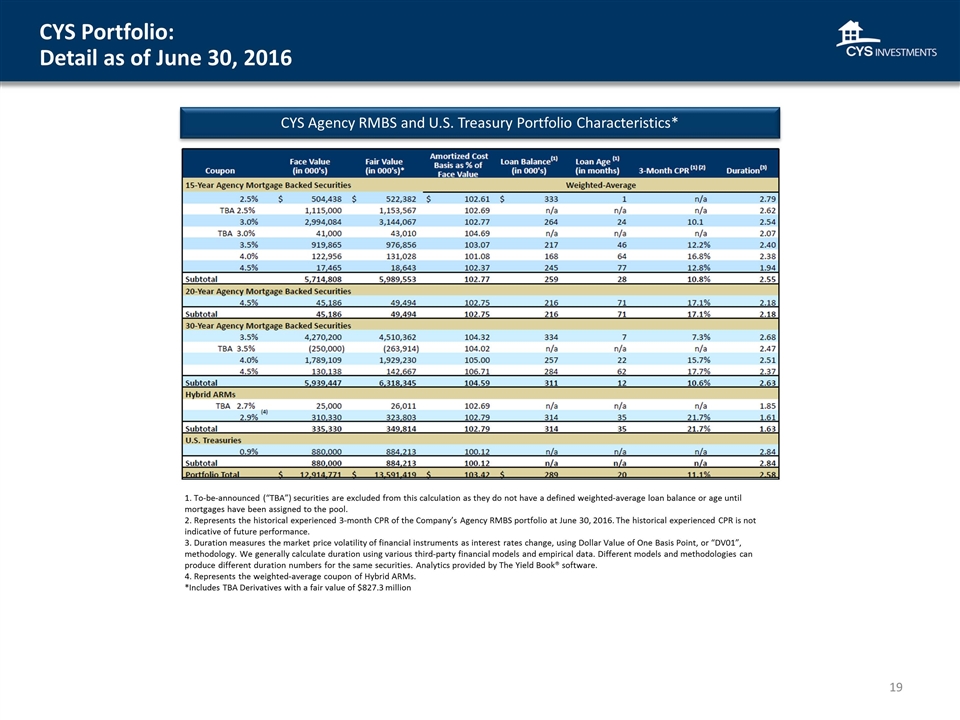
CYS Portfolio: Detail as of June 30, 2016 CYS Agency RMBS and U.S. Treasury Portfolio Characteristics* UPDATE * UPDATE 1. To-be-announced (“TBA”) securities are excluded from this calculation as they do not have a defined weighted-average loan balance or age until mortgages have been assigned to the pool. 2. Represents the historical experienced 3-month CPR of the Company’s Agency RMBS portfolio at June 30, 2016. The historical experienced CPR is not indicative of future performance. 3. Duration measures the market price volatility of financial instruments as interest rates change, using Dollar Value of One Basis Point, or “DV01”, methodology. We generally calculate duration using various third-party financial models and empirical data. Different models and methodologies can produce different duration numbers for the same securities. Analytics provided by The Yield Book® software. 4. Represents the weighted-average coupon of Hybrid ARMs. *Includes TBA Derivatives with a fair value of $827.3 million
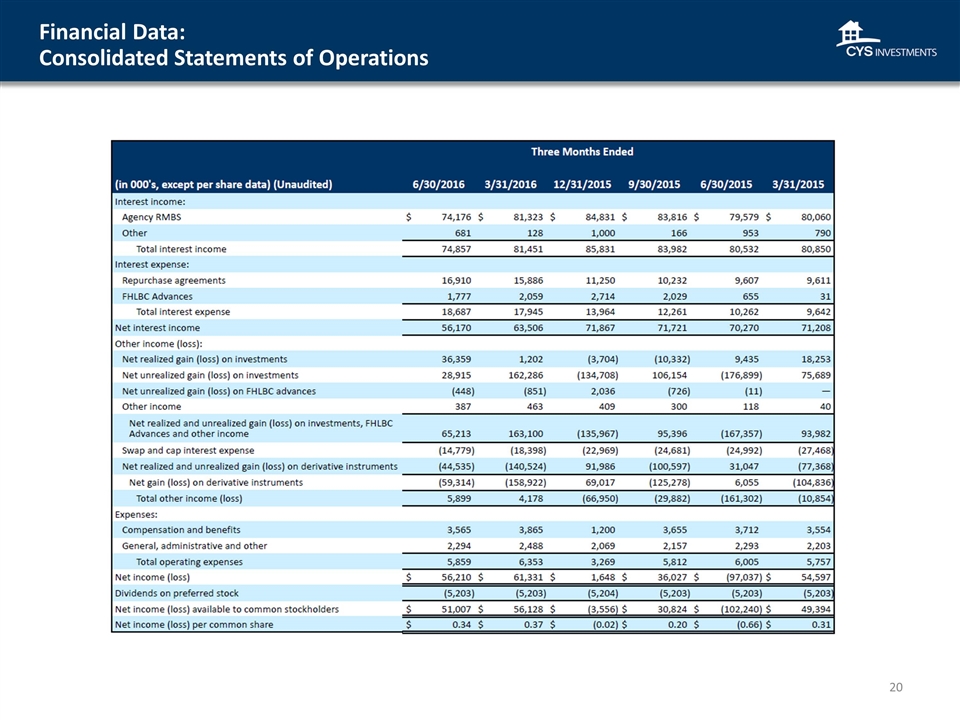
Financial Data: Consolidated Statements of Operations
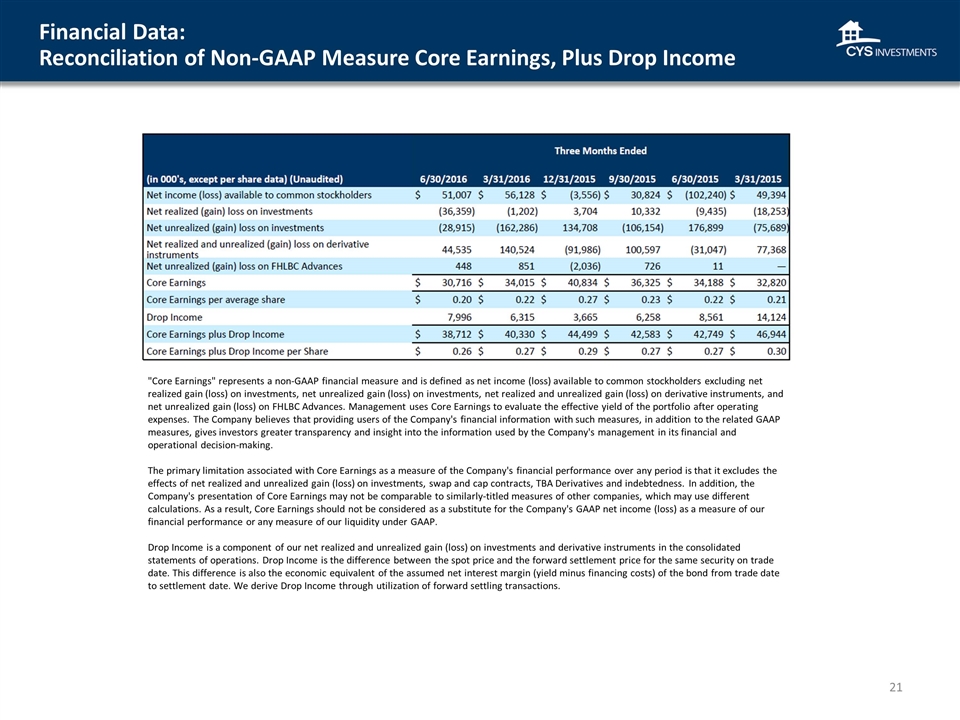
Financial Data: Reconciliation of Non-GAAP Measure Core Earnings, Plus Drop Income "Core Earnings" represents a non-GAAP financial measure and is defined as net income (loss) available to common stockholders excluding net realized gain (loss) on investments, net unrealized gain (loss) on investments, net realized and unrealized gain (loss) on derivative instruments, and net unrealized gain (loss) on FHLBC Advances. Management uses Core Earnings to evaluate the effective yield of the portfolio after operating expenses. The Company believes that providing users of the Company's financial information with such measures, in addition to the related GAAP measures, gives investors greater transparency and insight into the information used by the Company's management in its financial and operational decision-making. The primary limitation associated with Core Earnings as a measure of the Company's financial performance over any period is that it excludes the effects of net realized and unrealized gain (loss) on investments, swap and cap contracts, TBA Derivatives and indebtedness. In addition, the Company's presentation of Core Earnings may not be comparable to similarly-titled measures of other companies, which may use different calculations. As a result, Core Earnings should not be considered as a substitute for the Company's GAAP net income (loss) as a measure of our financial performance or any measure of our liquidity under GAAP. Drop Income is a component of our net realized and unrealized gain (loss) on investments and derivative instruments in the consolidated statements of operations. Drop Income is the difference between the spot price and the forward settlement price for the same security on trade date. This difference is also the economic equivalent of the assumed net interest margin (yield minus financing costs) of the bond from trade date to settlement date. We derive Drop Income through utilization of forward settling transactions.
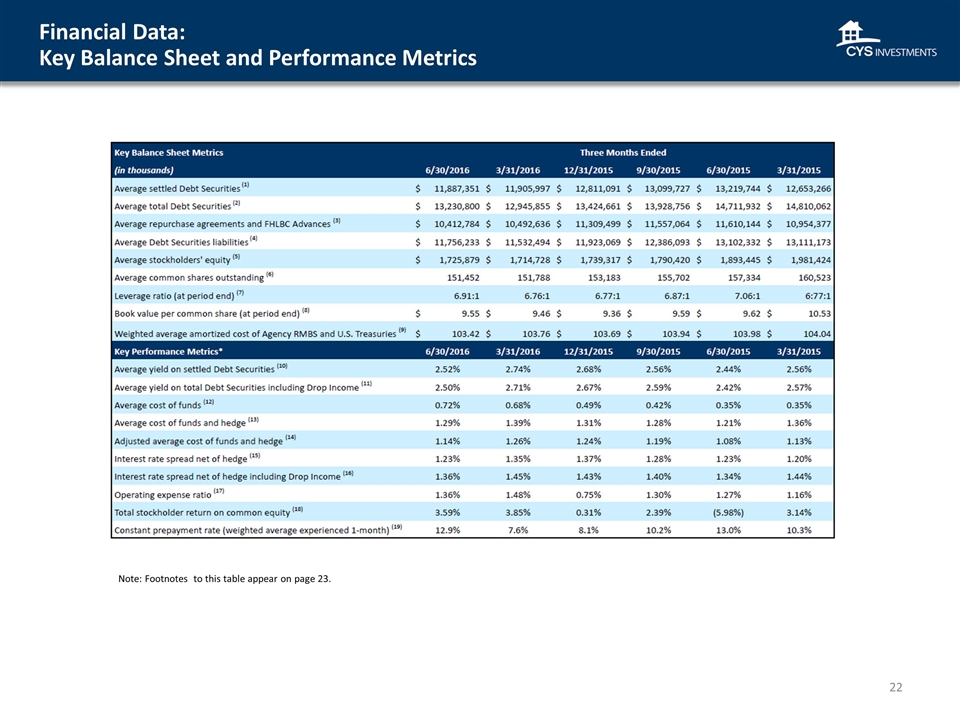
Financial Data: Key Balance Sheet and Performance Metrics Note: Footnotes to this table appear on page 23.
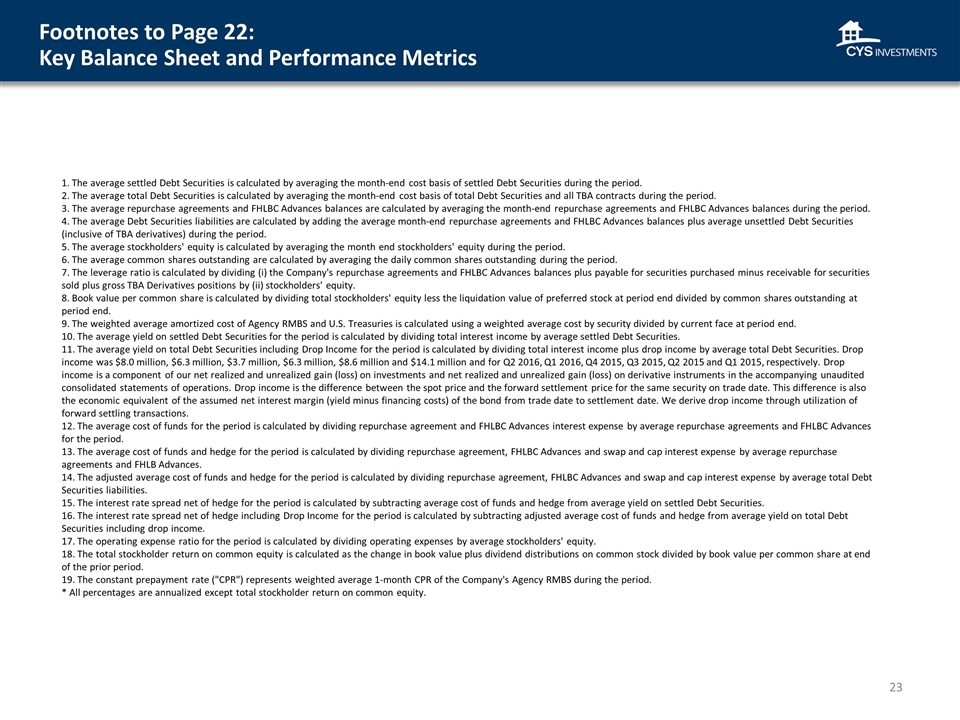
Footnotes to Page 22: Key Balance Sheet and Performance Metrics 1. The average settled Debt Securities is calculated by averaging the month-end cost basis of settled Debt Securities during the period. 2. The average total Debt Securities is calculated by averaging the month-end cost basis of total Debt Securities and all TBA contracts during the period. 3. The average repurchase agreements and FHLBC Advances balances are calculated by averaging the month-end repurchase agreements and FHLBC Advances balances during the period. 4. The average Debt Securities liabilities are calculated by adding the average month-end repurchase agreements and FHLBC Advances balances plus average unsettled Debt Securities (inclusive of TBA derivatives) during the period. 5. The average stockholders' equity is calculated by averaging the month end stockholders' equity during the period. 6. The average common shares outstanding are calculated by averaging the daily common shares outstanding during the period. 7. The leverage ratio is calculated by dividing (i) the Company's repurchase agreements and FHLBC Advances balances plus payable for securities purchased minus receivable for securities sold plus gross TBA Derivatives positions by (ii) stockholders' equity. 8. Book value per common share is calculated by dividing total stockholders' equity less the liquidation value of preferred stock at period end divided by common shares outstanding at period end. 9. The weighted average amortized cost of Agency RMBS and U.S. Treasuries is calculated using a weighted average cost by security divided by current face at period end. 10. The average yield on settled Debt Securities for the period is calculated by dividing total interest income by average settled Debt Securities. 11. The average yield on total Debt Securities including Drop Income for the period is calculated by dividing total interest income plus drop income by average total Debt Securities. Drop income was $8.0 million, $6.3 million, $3.7 million, $6.3 million, $8.6 million and $14.1 million and for Q2 2016, Q1 2016, Q4 2015, Q3 2015, Q2 2015 and Q1 2015, respectively. Drop income is a component of our net realized and unrealized gain (loss) on investments and net realized and unrealized gain (loss) on derivative instruments in the accompanying unaudited consolidated statements of operations. Drop income is the difference between the spot price and the forward settlement price for the same security on trade date. This difference is also the economic equivalent of the assumed net interest margin (yield minus financing costs) of the bond from trade date to settlement date. We derive drop income through utilization of forward settling transactions. 12. The average cost of funds for the period is calculated by dividing repurchase agreement and FHLBC Advances interest expense by average repurchase agreements and FHLBC Advances for the period. 13. The average cost of funds and hedge for the period is calculated by dividing repurchase agreement, FHLBC Advances and swap and cap interest expense by average repurchase agreements and FHLB Advances. 14. The adjusted average cost of funds and hedge for the period is calculated by dividing repurchase agreement, FHLBC Advances and swap and cap interest expense by average total Debt Securities liabilities. 15. The interest rate spread net of hedge for the period is calculated by subtracting average cost of funds and hedge from average yield on settled Debt Securities. 16. The interest rate spread net of hedge including Drop Income for the period is calculated by subtracting adjusted average cost of funds and hedge from average yield on total Debt Securities including drop income. 17. The operating expense ratio for the period is calculated by dividing operating expenses by average stockholders' equity. 18. The total stockholder return on common equity is calculated as the change in book value plus dividend distributions on common stock divided by book value per common share at end of the prior period. 19. The constant prepayment rate ("CPR") represents weighted average 1-month CPR of the Company's Agency RMBS during the period. * All percentages are annualized except total stockholder return on common equity.

Kevin E. Grant, CFA Chief Executive Officer and President Investment Outlook September 2016 Barclays Global Financial Services Conference September 12, 2016
